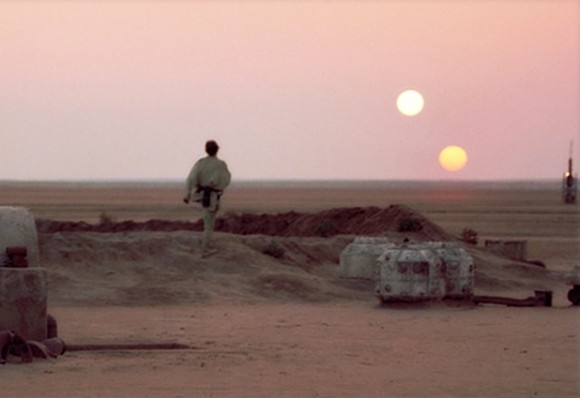Lord Smurf asks
I can just about get my head around a planet orbiting two suns, but this: http://www.bbc.co.uk/news/science-environment-19950923 confuses me. I notice that it says two of the suns are ‘circling’ the planet, rather than ‘orbiting’. Is there a difference? I always think of suns as the giants of solar system so I don’t understand how they can orbit a planet, rather than the other way round. How does this system actually work because all the articles are telling me how amazing this is but none of them actually say how the damn thing works.
That news article is rather spectacularly contentless. Fortunately – and unsually for the BBC – they included a link to the paper in the article (do this more often, journalists) which does explain what is going on pretty well. It’s written in the usual scientific hieroglyphics, but then that’s what you have me around for, isn’t it?
The title of the paper is a big clue as to what is going on: it’s called “Planet Hunters: A Transiting Circumbinary Planet in a Quadruple Star System”. There’s two stars orbiting a common barycentre in a classic binary setup, and this is what the planet they’ve found is orbiting, as seen below:
What you’re looking at here are the various dips in the overall intensity of the light observed from this binary system as the objects within it pass in front of each other; when they do this they block some of the light from reaching the Earth just like an eclipse. The primary and secondary eclipses labelled on the graph are caused by each of the binary star pair eclipsing the other. I’m going to take a wild guess and say the primary is bigger than the secondary, which is why it blocks more light and results in a bigger dip in the light graph when it eclipses. However, there’s also a couple of tiny, tiny dips not associated with either member of the binary system, and this is caused by the planet they’ve found.
Planets orbiting binary systems aren’t hugely unusual, and they can orbit one or both stars in the binary without any apparent ill-effects. The surprising thing about this particular discovery is what happened when the astronomers zoomed out a little bit.
The second point of light in the bottom left hand corner – catchily termed the 0.7” contaminator – is a second binary star system orbiting the first at a distance of greater than 1000 AU, effectively making it a quadruple star system. This second pair of stars is rather small and dim in comparison to the first, orbiting at a distance of about 40 AU from each other, and since both of them are so far away there’s nothing that says a planet can’t exist perfectly happily in an orbit close in to the primary binary system (the paper mentions that something called “eccentricity pumping” happens in models where the second binary system is closer than that, which I imagine refers to repeated gravitational perturbations from the second binary gradually stretching out the orbit of a planet into an increasingly elliptical shape until it finally breaks free and is ejected from the star system entirely).
And that’s it, really. That BBC news article is awfully written and mixes up what is orbiting what, when it’s actually a fairly simple thing to understand: the primary binary system has most of the gravitational pull in this system and it’s this the planet orbits. The secondary binary is weakly bound to the primary in a circular orbit and is both smaller and much further away from the planet than the primary, which is what allows the planet to survive.




Okay, just to clear things up in my mind, The secondary binary is orbiting the primary binary system? So we have suns orbiting suns?
Well, do you remember the post on barycentres? Planets don’t orbit a sun in the strictest sense, they orbit a common centre of gravity somewhere between the two. Usually this is only a short distance from the actual centre of gravity of the sun because stars are so sodding huge, but there is a difference and it does count.
So that second binary system will be orbiting a barycentre somewhere in between them and the primary binary, and the primary binary will be orbiting this too. This barycentre will still be very close to the primary pair because the secondary is so small, but because there are four bodies involved the dynamics of the system are far more complicated.
(Also, binary stars already orbit each other. You’ve already got suns orbiting suns. This is just a case of binaries orbiting binaries.)
See this: http://i47.tinypic.com/282uw.jpg is what I have pictured in my head and I don’t think it’s right. I didn’t really understand the image they had made in the linked paper.
That’s probably the best way of thinking about it without having an aneurysm. In reality the barycentres are going to be constantly shifting as everything moves around in their orbits, but since this is apparently a stable configuration over solar system timescales (stable enough for a planet to form and survive, anyway) I would expect those shifts to be small and self-correcting.
You gonna cover the Alpha Centauri B news? If only for the SMAC jokes.
Wow, SMAC really was an actual literal roadmap to the future.
Brian Reynolds is actually from the future. Actually, scratch that, he joined Zynga, he can’t be that smart. (Fun fact: Zynga’s stock now is worth less than their total assets)
The Brian Reynolds that joined Zynga is actually a pod person. It’s the only explanation.
(Been having some problems with spam and my spam filter being overzealous which should hopefully be fixed now.)
Doesn’t the planet they found have a surface temperature of 1,500*C?
And an orbital period of three days, but if it has one it likely has more.